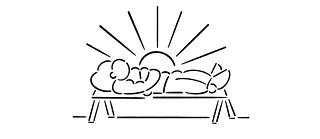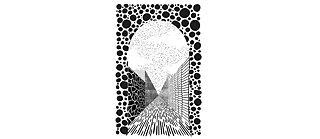Work and Leisure
Vagrants: A Law to Eradicate the Plague
Our ancestors drafted the law to reduce vagrancy in Mexico City. Today in the 21st century, they should be more than satisfied with their efforts.
“If ever there was a war between work and leisure, it is over, and the vagrants have been vanquished.”
Against Working Life, Rafael Lemus
In the summer of 1853, the government decree of the Ley para corregir la vagancia (Law to Correct Vagrancy) was published in what is now Mexico City. The vagrants, according to that law decreed by Saint Anna, are those who do not have a trade, profession, occupation, salary, or “lawful” means to live. Those who, even having income or assets, do nothing more than gamble or visit prostitutes, cafes, taverns, and other “suspicious places.” Those who beg. Those who only work half a day. Young foreigners who wander about aimlessly. Begging orphans.
Vagrancy, according to this legal definition influenced by the Spanish legislation of 1745, was morally reprehensible. But the Mexicans decided to include among vagrants people who did things, workers whom the state wanted to control: healers whose herbs and traditional remedies sought to replace doctors’ services, crooks who started disputes only to settle them for payment, gamblers, musicians, and wanderers who roamed from town to town to ensure their survival.
The vagrancy law was also very class-based. Not all vagrants were pursued, only the masses. To eradicate vagrancy, they were sent to correctional facilities, poorhouses, factories, and haciendas. The punishment, according to that law, was to help the vagrants get used to working. They should learn to love working.
The intent behind eradicating vagrants, wrote Lucio E. Maldonado Ojeda in his article, “The Tribunal for Vagrants in 19th-Century Mexico City: An Introduction” published in the Official Gazette of the National Institute of Anthropology and History (April–June 2003), was to control the poor, unemployed urban population who posed a threat to the property and security of the upper classes in a historical period that analysts called “anarchy.”
How could we waste the creative power of our minds or the strength of our muscles in the midst of the Industrial Revolution? With machines pumping energy and steam, with the temptation to turn bodies into machines, with the promise of development just around the corner, with the exuberance and abundance of resources in nature ready to be turned into something useful... Who would have the nerve to do nothing, to watch life pass them by?
Unimaginable.
Vagrancy and leisure then became the object of attack, and the Tribunal for Vagrants in Mexico City was charged with the task. There were several institutions of its kind throughout the country created to put a stop to the increasing threat of vagrants and beggars swarming the city. In short, writes Maldonado Ojeda, the Tribunal was “played an important role in surveilling the masses” because it alone determined who should be taught to love working.
Etymologically, the word “work” comes from the Latin tripaliare, which derives from tripalium, and means “three sticks.” This refers to an instrument of torture consisting of three stakes, which were tied to slaves or criminals to whip them. However, the meaning of the word does not relate to the punishment itself but to the suffering associated with it. When the word began to be used in reference to one’s profession, work was, for the most part, a physical effort — tilling, harvesting, shepherding, plowing, and at the end of the day, workers felt wounded, beaten.
Today in the 21st century, our ancestors who drafted the law to reduce vagrancy should be more than satisfied with their efforts: We earthlings are all about work seven days a week, even on the day of creation and the day of rest. As Rafael Lemus writes in his classic essay “Contra la vida active” that the war between work and leisure has come to an end, and leisure has been vanquished. Work encompasses everything. Work is everything. Work is good. Those who work are good. I remember that when I was a child, I learned to fear the homeless who fell asleep under the shade of a tree or walked along the train tracks through the neighborhood “aimlessly and uselessly”: Beware of vagrants, you never know what they are looking for. And I learned not only to fear them but also to fear being like them.
We work outside the factory and the office, we work because the labor rights, decent wage, and social benefits that once guaranteed retirement in our old age have vanished. We work because we believe that we exist in the world, that we are people precisely because of our work. When we are introduced to a person, one of the first questions we ask is: What’s your line of work? What do you do? We work even when we are not working. We work, Lemus says from his hammock, “to keep feeding the mythos of work.”
We have convinced ourselves that sometimes the work we do is not for subsistence but as a reward, to achieve something greater — whether material or symbolic, such as renown or prestige. And as soon as we have it, we want more. Chasing after work, we have lost sight of why we do it and what we are pursuing.
During this rat race, we have lost perspective. We no longer know what we are trying to achieve or why. Now that work has become such a huge part of our lives, I wonder: At what point did we begin to believe that the purpose of life was to move forward, evolve, possess, and accumulate capital? I think of scientist and biotechnologist Mauricio de la Puente’s theory on nomadic life: The nomad cultivates roads. He is not a hunter or gatherer who collects things in order to survive and exploits to accumulate what he finds across his path. He understands abundance not as taking but as giving. One gives along the way. If there are no bees on his land, it’s because there are no flowers, so the nomad cultivates the land so that the bees will come. Work, then, takes on another meaning that is very different from what I have heard throughout my life that the purpose of work is to get somewhere and possess something. In his work, the nomad creates these conditions not as an exercise in control but as freedom of movement.
I think about us: the vagrants, the nomads, me. I begin to feel envious of those vagrants, the do-nothings, the idlers targeted by the Tribunal, the nomads who understood that life is not as cyclical as work leads us to believe. I would like to have the attitude of that man lying in the middle of the sidewalk, soaking up the sun’s rays, whose path I cross on my way to an appointment. I would like to be lying on the sofa next to the dog as he stretches every muscle of his body and enjoys the simple pleasure of being alive. I am starting to feel like walking, not to accumulate but to cultivate.
As I write this text about leisure, I envy them more and more. But I chose to accept this invitation. And here I am, writing on my day off, doing what is expected of me: thinking, writing, producing. Reading essays on rest and boredom while I’m on the train, pondering those ideas while I walk my daughters to school, writing while my soup is cooking, revising in my mind while taking a bath. What if I had said no to writing this text and instead applied its lessons to my life, oscillating between leisure and laziness. Although knowing me, that moment of tedium would surely be eclipsed by my urgency to be something, to seize every second of my life and turn it into a relatable, quantifiable experience.
Oh, what a shame that I don’t even need a Tribunal for Vagrants to harass and persecute me to teach me the point of work, to love work, because I myself — as Byung-Chul Han warned us in his book The Burnout Society — exploit myself and live “with the anguish of not always doing everything that can be done.” I chase myself with the whip, thinking that I am closer to reaching the goal, although I don’t know what the goal is.
Woe is me that I persecute myself and convince myself of the relevance of being relevant, of producing, of doing, of being, and of leaving a record of it.
This article originally appeared in the book, Blickwinkel: marasmo, edited by the Goethe-Institut México, published by Pitzilein Books.
Against Working Life, Rafael Lemus
In the summer of 1853, the government decree of the Ley para corregir la vagancia (Law to Correct Vagrancy) was published in what is now Mexico City. The vagrants, according to that law decreed by Saint Anna, are those who do not have a trade, profession, occupation, salary, or “lawful” means to live. Those who, even having income or assets, do nothing more than gamble or visit prostitutes, cafes, taverns, and other “suspicious places.” Those who beg. Those who only work half a day. Young foreigners who wander about aimlessly. Begging orphans.
Vagrancy, according to this legal definition influenced by the Spanish legislation of 1745, was morally reprehensible. But the Mexicans decided to include among vagrants people who did things, workers whom the state wanted to control: healers whose herbs and traditional remedies sought to replace doctors’ services, crooks who started disputes only to settle them for payment, gamblers, musicians, and wanderers who roamed from town to town to ensure their survival.
The vagrancy law was also very class-based. Not all vagrants were pursued, only the masses. To eradicate vagrancy, they were sent to correctional facilities, poorhouses, factories, and haciendas. The punishment, according to that law, was to help the vagrants get used to working. They should learn to love working.
The intent behind eradicating vagrants, wrote Lucio E. Maldonado Ojeda in his article, “The Tribunal for Vagrants in 19th-Century Mexico City: An Introduction” published in the Official Gazette of the National Institute of Anthropology and History (April–June 2003), was to control the poor, unemployed urban population who posed a threat to the property and security of the upper classes in a historical period that analysts called “anarchy.”
How could we waste the creative power of our minds or the strength of our muscles in the midst of the Industrial Revolution? With machines pumping energy and steam, with the temptation to turn bodies into machines, with the promise of development just around the corner, with the exuberance and abundance of resources in nature ready to be turned into something useful... Who would have the nerve to do nothing, to watch life pass them by?
Unimaginable.
Vagrancy and leisure then became the object of attack, and the Tribunal for Vagrants in Mexico City was charged with the task. There were several institutions of its kind throughout the country created to put a stop to the increasing threat of vagrants and beggars swarming the city. In short, writes Maldonado Ojeda, the Tribunal was “played an important role in surveilling the masses” because it alone determined who should be taught to love working.
Etymologically, the word “work” comes from the Latin tripaliare, which derives from tripalium, and means “three sticks.” This refers to an instrument of torture consisting of three stakes, which were tied to slaves or criminals to whip them. However, the meaning of the word does not relate to the punishment itself but to the suffering associated with it. When the word began to be used in reference to one’s profession, work was, for the most part, a physical effort — tilling, harvesting, shepherding, plowing, and at the end of the day, workers felt wounded, beaten.
Today in the 21st century, our ancestors who drafted the law to reduce vagrancy should be more than satisfied with their efforts: We earthlings are all about work seven days a week, even on the day of creation and the day of rest. As Rafael Lemus writes in his classic essay “Contra la vida active” that the war between work and leisure has come to an end, and leisure has been vanquished. Work encompasses everything. Work is everything. Work is good. Those who work are good. I remember that when I was a child, I learned to fear the homeless who fell asleep under the shade of a tree or walked along the train tracks through the neighborhood “aimlessly and uselessly”: Beware of vagrants, you never know what they are looking for. And I learned not only to fear them but also to fear being like them.
We work outside the factory and the office, we work because the labor rights, decent wage, and social benefits that once guaranteed retirement in our old age have vanished. We work because we believe that we exist in the world, that we are people precisely because of our work. When we are introduced to a person, one of the first questions we ask is: What’s your line of work? What do you do? We work even when we are not working. We work, Lemus says from his hammock, “to keep feeding the mythos of work.”
We have convinced ourselves that sometimes the work we do is not for subsistence but as a reward, to achieve something greater — whether material or symbolic, such as renown or prestige. And as soon as we have it, we want more. Chasing after work, we have lost sight of why we do it and what we are pursuing.
During this rat race, we have lost perspective. We no longer know what we are trying to achieve or why. Now that work has become such a huge part of our lives, I wonder: At what point did we begin to believe that the purpose of life was to move forward, evolve, possess, and accumulate capital? I think of scientist and biotechnologist Mauricio de la Puente’s theory on nomadic life: The nomad cultivates roads. He is not a hunter or gatherer who collects things in order to survive and exploits to accumulate what he finds across his path. He understands abundance not as taking but as giving. One gives along the way. If there are no bees on his land, it’s because there are no flowers, so the nomad cultivates the land so that the bees will come. Work, then, takes on another meaning that is very different from what I have heard throughout my life that the purpose of work is to get somewhere and possess something. In his work, the nomad creates these conditions not as an exercise in control but as freedom of movement.
I think about us: the vagrants, the nomads, me. I begin to feel envious of those vagrants, the do-nothings, the idlers targeted by the Tribunal, the nomads who understood that life is not as cyclical as work leads us to believe. I would like to have the attitude of that man lying in the middle of the sidewalk, soaking up the sun’s rays, whose path I cross on my way to an appointment. I would like to be lying on the sofa next to the dog as he stretches every muscle of his body and enjoys the simple pleasure of being alive. I am starting to feel like walking, not to accumulate but to cultivate.
As I write this text about leisure, I envy them more and more. But I chose to accept this invitation. And here I am, writing on my day off, doing what is expected of me: thinking, writing, producing. Reading essays on rest and boredom while I’m on the train, pondering those ideas while I walk my daughters to school, writing while my soup is cooking, revising in my mind while taking a bath. What if I had said no to writing this text and instead applied its lessons to my life, oscillating between leisure and laziness. Although knowing me, that moment of tedium would surely be eclipsed by my urgency to be something, to seize every second of my life and turn it into a relatable, quantifiable experience.
Oh, what a shame that I don’t even need a Tribunal for Vagrants to harass and persecute me to teach me the point of work, to love work, because I myself — as Byung-Chul Han warned us in his book The Burnout Society — exploit myself and live “with the anguish of not always doing everything that can be done.” I chase myself with the whip, thinking that I am closer to reaching the goal, although I don’t know what the goal is.
Woe is me that I persecute myself and convince myself of the relevance of being relevant, of producing, of doing, of being, and of leaving a record of it.
References
- Lucio E. Maldonado Ojeda en su artículo El tribunal de vagos de la Ciudad de México del siglo XIX. Una introducción (The Tribunal for Vagrants in 19th-Century Mexico City: An Introduction)
- Rafael Lemus, Contra la vida active (Against Working Life)
- Paul Lafagarde, The Right to Be Lazy
- Byung-Chul Han, The Burnout Society
- Mauricio de la Puente, his theory of Cyclic Times
This article originally appeared in the book, Blickwinkel: marasmo, edited by the Goethe-Institut México, published by Pitzilein Books.







